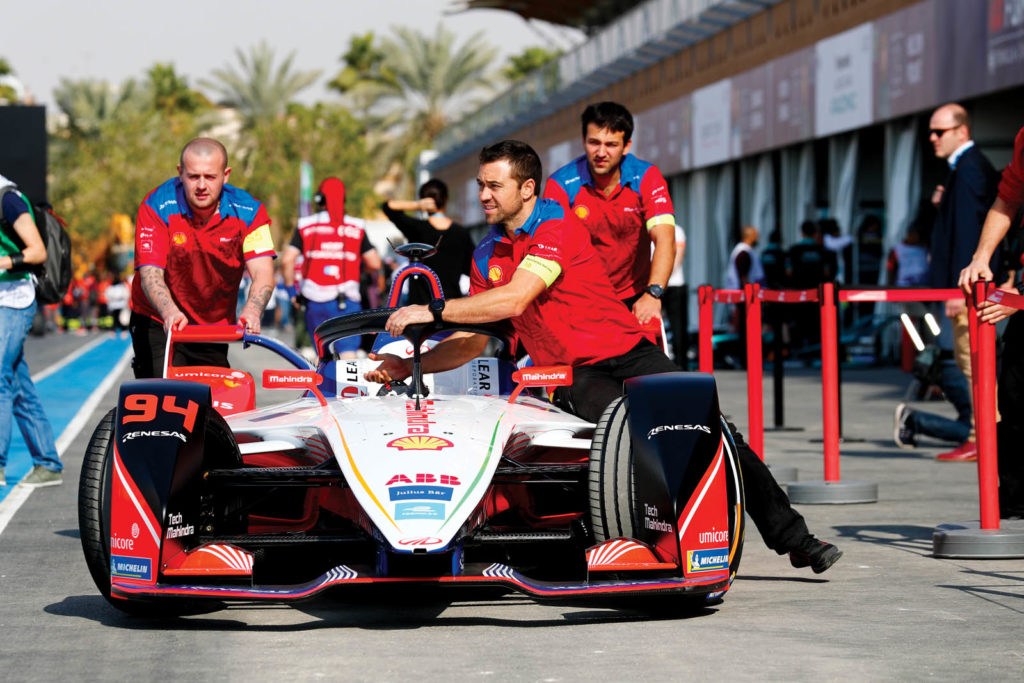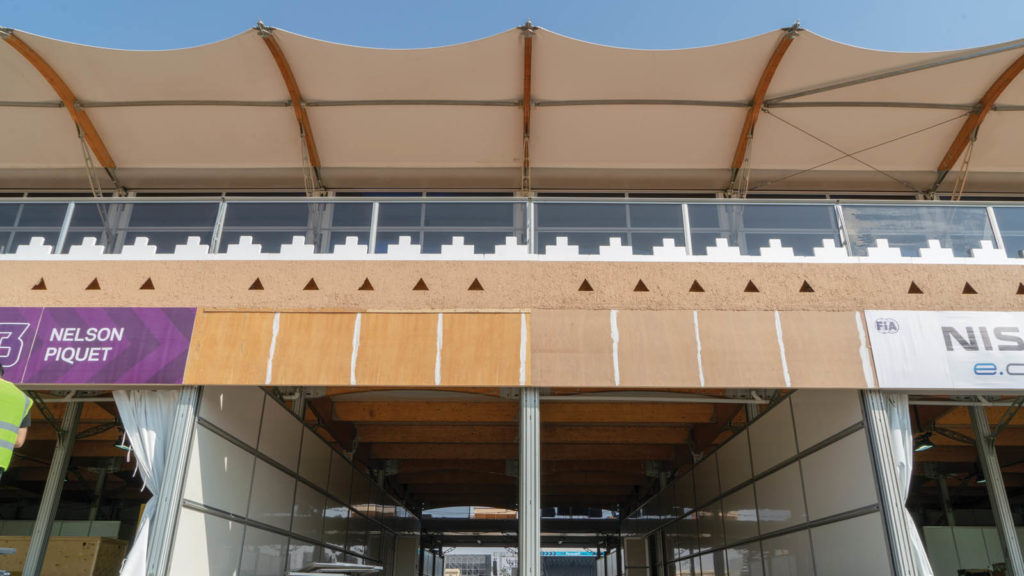Losberger De Boer meets the challenges of designing and installing a Formula E pit lane structure in Saudi Arabia.
by Jeff Moravec
When Losberger De Boer signed on for an installation related to the first electric Grand Prix car race ever held in Saudi Arabia, the company was in uncharted territory, according to Paul Machin, the company’s senior sales manager in the Middle East.
“This is a story of many firsts,” he says.

The 2018 Saudia Ad Diriyah E-Prix Formula E electric car race was scheduled for mid-December at the Riyadh Street Circuit in the town of Diriyah, near the Saudi Arabian capital of Riyadh. Formula E is a class of motorsports that uses only electric cars, and the races take place on temporary tracks in city centers.
Global sports promoter and event production company CBX, based in Monaco, was in charge of finding a firm to construct a 190-meter-long pit lane building, as well as hospitality and outdoor viewing facilities. Losberger De Boer, based in Bad Rappenau, Germany, is a global provider of temporary structures.
The request for proposal called for a basic structure without much emphasis on aesthetics, Machin says.

“Something unique was not a prerequisite, but that’s what we gave them,” he says. “We were really looking to build something that would provide a better overall experience. Once they saw our designs and the Grand Prix work we’d done previously, they knew what we could deliver to make it a better race.”
Machin says the task was to build a temporary, solid, high-quality structure that could be integrated easily into a seamless complex with pit lane facilities at racetrack level and VIP hospitality facilities. Visitor viewing platforms also needed to be constructed on the second level.
The goal, says Machin, was to produce a structure so that “visitors would be able to experience the feeling of electric motorsport in the best and closest way.”
That’s when the challenges started.
Time frame and logistics
“Very often here orders and signatures come really late,” Machin says. “With some of our kit coming from Europe to Saudi Arabia by boat, with some special parts by airfreight, the time frame was really tight. From signature to event day was about 10 weeks, which is unheard of.”
Logistics were an issue as well. “The event took place in a busy part of the city,” he says. “We had to keep the level of traffic disruption on surrounding roads and access ways to an absolute minimum. This was especially challenging as the pit lane structure had to be built next to an active public road, creating access restrictions.
“It was very much a learning curve for us,” he adds. “But with careful advance planning, our project team was able to maneuver the necessary lifting equipment into place in a safe and compliant way, while ensuring the original timetable was maintained.”

Because it was one of the first major sporting events ever held in Saudi Arabia, Machin says it was difficult to find staff or subcontractors in the country with knowledge of temporary structures and build experience.
“It was necessary for our team to fly in experienced event structure builders from the United Arab Emirates and Europe,” he says. “That was expensive, but it ensured the project was delivered on deadline and according to safety standards.”
Losberger De Boer also had to make sure that the company was building a structure that could be dismantled quickly, so that interruption of the city’s normal business would be minimized.
Meeting safety standards
Finally, safety was key—the structure utilized fire-resistant materials, and installers took special measures to anchor it. The pit lane structure met the strict international standards of EN NEN 13782, ISO 9001, 14001 and SCC.
The race was held before more than 23,000 spectators.
“Everybody who was there, from the ministry to royalty, all saw how well our structure worked and how good it looked,” Machin says. “It looked and felt like it should be there, not like a tent.”
The project earned the Award of Excellence in the Corporate Tent Rental category in the International Achievement Awards (IAA), announced in October at IFAI Expo 2019 in Orlando, Fla.
Production company CBX was happy with the outcome as well. “This project was very important for us,” Carlo Boutagy, the company’s CEO, wrote in Losberger De Boer’s IAA submission. “The team worked exceptionally well to complete the structure on time and has proven to be a reliable partner.”
Given that the race was the first of its kind to be held in Saudi Arabia, Machin says Losberger De Boer’s participation was notable. “It’s prestigious to be involved in such an international event,” he says. “To have our structure right in the middle with all the cameras pointed right at [it] . . . that’s invaluable for our company.”
Jeff Moravec is a freelance writer based in Minneapolis, Minn.
 TEXTILES.ORG
TEXTILES.ORG


